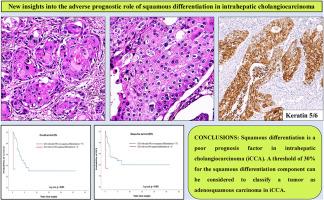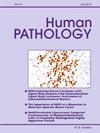New insights into the adverse prognostic role of squamous differentiation in intrahepatic cholangiocarcinoma: A comprehensive analysis
IF 2.6
2区 医学
Q2 PATHOLOGY
引用次数: 0
Abstract
Objectives
Squamous differentiation is uncommon in intrahepatic cholangiocarcinoma (iCCA) with limited systematic studies in the literature, mostly case reports. The study aimed to determine the rate of squamous differentiation in iCCA utilizing markers p63, Keratin 5/6, and p40, and to examine its correlation with clinicopathological characteristics and survival outcomes.
Methods and results
A retrospective analysis was performed on 147 patients with histologically confirmed iCCA based on surgical specimens. A sample was classified as having squamous differentiation if it exhibited a solid growth pattern of polygonal tumor cells with keratinization or a solid growth pattern with at least the positivity of two of the three abovementioned markers. The rate of squamous differentiation in iCCA was determined to be 12.9 % (19/147). p40 demonstrates the highest sensitivity and specificity for identifying squamous differentiation in iCCA, recorded at 94.7 % and 87.5 %, respectively. Squamous differentiation in iCCA was found to be associated with large tumor size, large bile duct subtype, poorly differentiated adenocarcinoma component, activated tumor microenvironment, tumor necrosis, high tumor budding, increased invasiveness, and advanced pT stages. Patients with greater than 30 % squamous differentiation had significantly shorter median overall survival and disease-free survival than controls.
Conclusions
These results suggest that squamous differentiation serves as an unfavorable prognosis factor in iCCA, and a threshold of 30 % for the squamous differentiation component can be considered to classify a tumor as adenosquamous carcinoma in iCCA.

对肝内胆管癌鳞状分化不良预后作用的新认识:一项综合分析。
目的:鳞状分化在肝内胆管癌(iCCA)中并不常见,文献中系统研究有限,主要是病例报告。本研究旨在利用标记物p63、角蛋白5/6和p40来确定iCCA的鳞状分化率,并研究其与临床病理特征和生存结果的相关性。方法与结果:回顾性分析147例手术标本组织学证实的iCCA患者。如果一个样本显示出具有角化的多边形肿瘤细胞的实体生长模式,或者至少具有上述三种标记物中的两种阳性的实体生长模式,则该样本被归类为具有鳞状分化。iCCA的鳞状分化率为12.9%(19/147)。p40在鉴别iCCA鳞状分化方面的敏感性和特异性最高,分别为94.7%和87.5%。发现iCCA的鳞状分化与肿瘤体积大、胆管亚型大、腺癌成分分化差、肿瘤微环境活化、肿瘤坏死、肿瘤出芽高、侵袭性增加和pT分期晚期相关。鳞状分化大于30%的患者的中位总生存期和无病生存期明显短于对照组。结论:这些结果提示,鳞状分化是iCCA的一个不利预后因素,鳞状分化成分的阈值为30%可视为iCCA的腺鳞状癌。
本文章由计算机程序翻译,如有差异,请以英文原文为准。
求助全文
约1分钟内获得全文
求助全文
来源期刊

Human pathology
医学-病理学
CiteScore
5.30
自引率
6.10%
发文量
206
审稿时长
21 days
期刊介绍:
Human Pathology is designed to bring information of clinicopathologic significance to human disease to the laboratory and clinical physician. It presents information drawn from morphologic and clinical laboratory studies with direct relevance to the understanding of human diseases. Papers published concern morphologic and clinicopathologic observations, reviews of diseases, analyses of problems in pathology, significant collections of case material and advances in concepts or techniques of value in the analysis and diagnosis of disease. Theoretical and experimental pathology and molecular biology pertinent to human disease are included. This critical journal is well illustrated with exceptional reproductions of photomicrographs and microscopic anatomy.
 求助内容:
求助内容: 应助结果提醒方式:
应助结果提醒方式:


